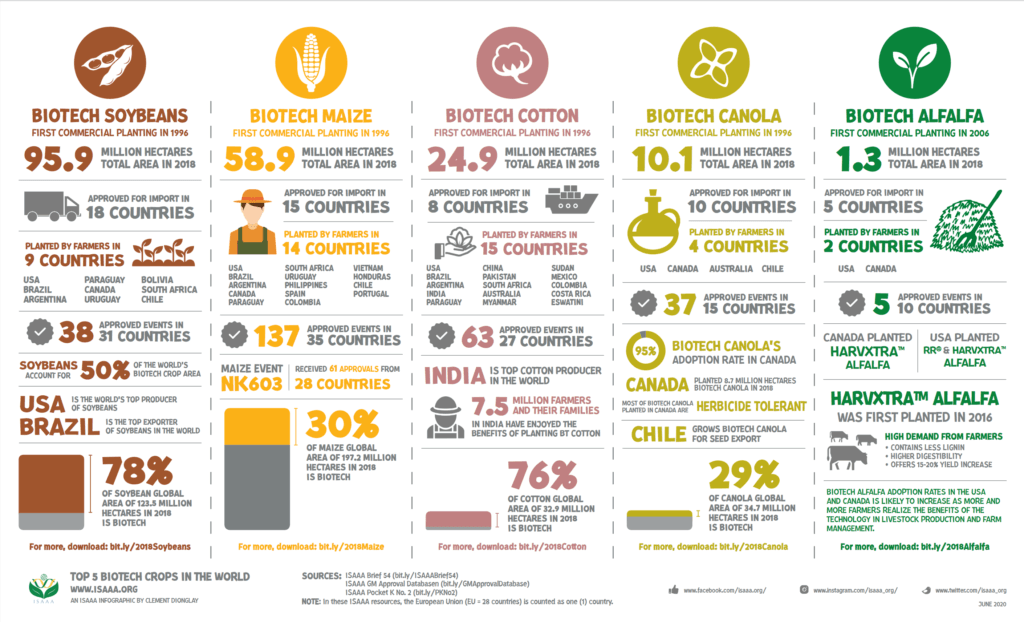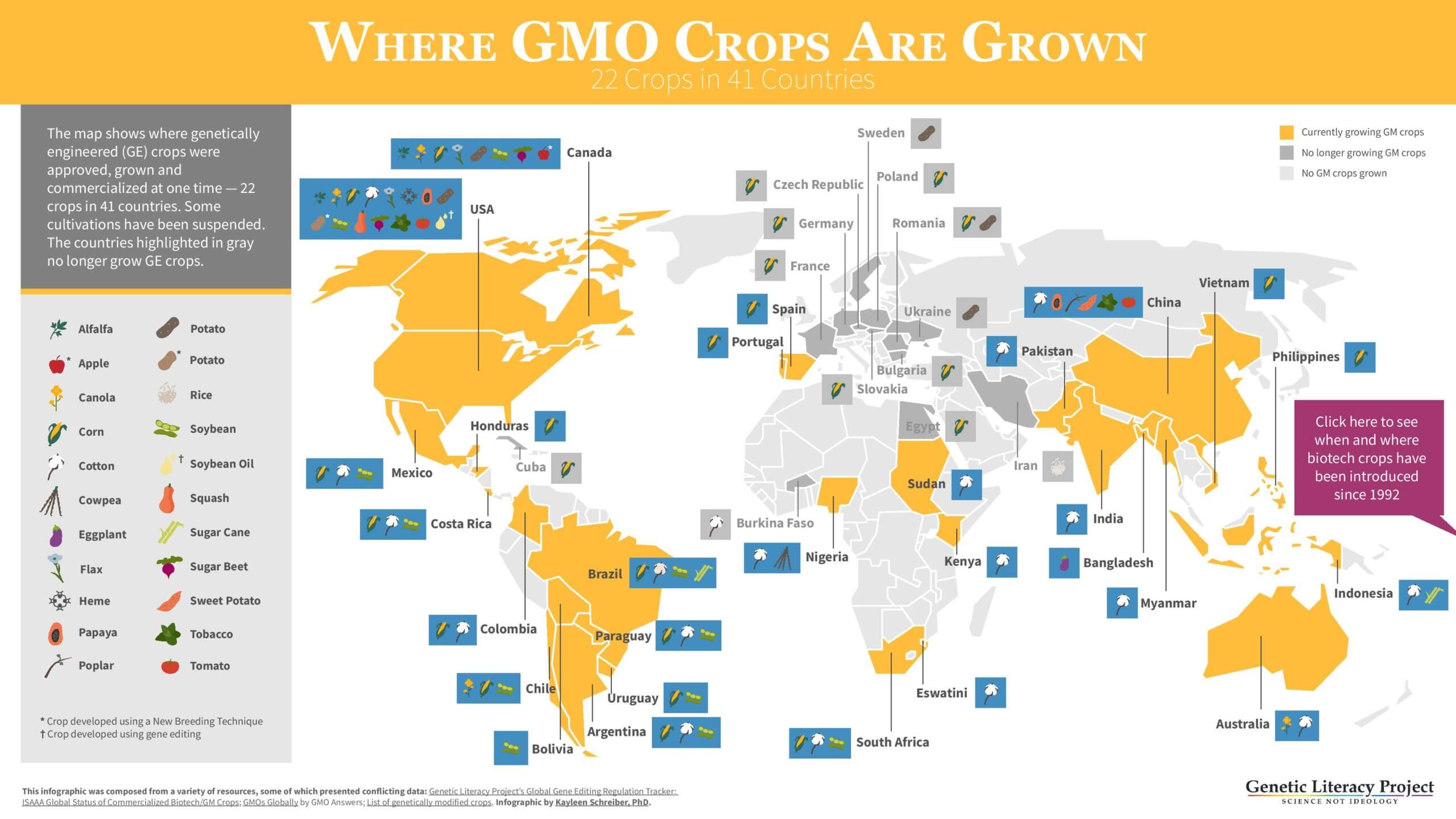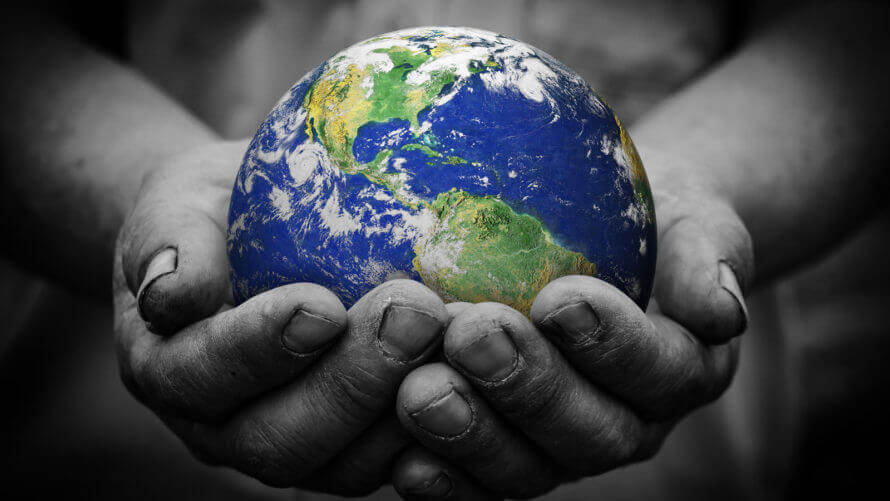The most recent data from the International Service for the Acquisition of Agri-biotech Applications (ISAAA) shows that more than 18 million farmers in 29 countries, including 19 developing nations, planted over 190 million hectares (469.5 million acres) of GMO crops in 2019. This represents a 5.7 percent increase over 2015, and the highest area of biotech crop adoption since cultivation began in 1996.
Countries growing GMO crops are: Argentina, Australia, Bangladesh, Bolivia, Brazil, Canada, Chile, China, Colombia, Costa Rica, Czech Republic, Honduras, India (Bt cotton only), Malawi, Mexico, Myanmar, Nigeria, Pakistan, Paraguay, Philippines, Portugal, South Africa, Slovakia, Spain, Sudan, eSwatini (Swaziland), United States, Uruguay, Vietnam, and Zambia.
Recently, a number of developing countries have allowed cultivation of GMOs, often on a case-by-case basis. These countries include Kenya (case by case), Zimbabwe (corn), India (Bt cotton), Burkina-Faso (Bt cotton), eSwatini (Bt cotton), Zambia (all crops) and Cuba (corn and soy).
Five biotech crops planted in all these countries occupy 99% of the global biotech crop area, ISAAA reported in 2020. The five major biotech crops planted at more than 1 million hectares are soybeans (95.9 million hectares), followed by maize (58.9 million hectares), cotton (24.9 million hectares), canola (10.1 million hectares), and alfalfa (1.2 million hectares).

On the flipside, there are dozens of nations that prohibit the cultivation of GMO crops, though estimates vary as regulations change. According to a 2013 analysis, 26 countries had total or partial bans on GMOs, “including Switzerland, Australia, Austria, China, India, France, Germany, Hungary, Luxembourg, Greece, Bulgaria, Poland, Italy, Mexico and Russia,” and that “significant restrictions on GMOs exist in about sixty other countries.” In 2015, anti-GMO group Sustainable Pulse said that 38 countries ban the cultivation of GMO crops. The group’s list includes Algeria and Madagascar in Africa; Turkey, Kyrgyzstan, Bhutan, and Saudi Arabia in Asia; Belize, Peru, Ecuador, and Venezuela in South and Central America; and 28 countries in Europe.
Russia is the most populous country to ban both the cultivation and importation of GMO crops. In 2014, Russia banned the importation of biotech crops, and officially banned their cultivation, with an exception allowed for scientific research. In 2020, Russia reversed the importation ban on soy, and has funded research on the development of gene-edited foods within its borders.
EU regulations give individual countries the right to block farmers from growing GMO crops. Using this opt-out process, 19 members, including Germany and France, voted in late 2015 to prohibit the cultivation of eight new biotech crops awaiting approval from regulators. They also chose to prohibit cultivation of the one GMO crop — an insect-resistant corn variety (MON810) — already approved for cultivation in the EU and grown in Spain and Portugal. The EU’s recent “Farm to Fork” (F2F) initiative, signed by the member states’ ministers of agriculture in October 2020, calls for 25 percent of Europe’s farmland to be converted to organic agricultural. The EU is awaiting council and committee decisions on the use of genetically engineered crops (possibly including transgenics and gene editing).
Although many EU countries do not grow GMOs, Europe is one of the world’s biggest consumers of them. Every EU nation imports them. More than 30 million tons of biotech corn and soy for livestock feed are imported each year, making Europe the largest regional consumer of GMOs in the world.
Countries with GMO prohibitions:
- Algeria: Cultivation banned. Imports banned.
- Australia: cultivation prohibited in Tasmania and Kangaroo island. Imports allowed.
- Austria: Cultivation prohibited. Imports allowed.
- Azerbaijan: Cultivation banned. Imports allowed.
- Belize: Cultivation banned. Imports allowed.
- Bhutan: Cultivation banned. Imports banned.
- Bosnia and Herzegovina: Cultivation banned. Imports allowed.
- Bulgaria: Cultivation prohibited. Imports allowed.
- Croatia: Cultivation prohibited. Imports allowed.
- Cyprus: Cultivation prohibited. Imports allowed.
- Denmark: Cultivation prohibited. Imports allowed.
- Ecuador: Cultivation banned. Imports allowed.
- France: Cultivation prohibited. Imports allowed.
- Germany: Cultivation prohibited. Imports allowed.
- Greece: Cultivation prohibited. Imports allowed.
- Hungary: Cultivation prohibited. Imports allowed.
- India: Bt cotton allowed, all others prohibited.
- Italy: Cultivation prohibited. Imports allowed.
- Kenya: Cultivation of white maize approved, all others prohibited. Import of white maize allowed.
- Kyrgyzstan: Cultivation banned. Imports banned.
- Latvia: Cultivation prohibited. Imports allowed.
- Lithuania: Cultivation prohibited. Imports allowed.
- Luxembourg: Cultivation prohibited. Imports allowed.
- Madagascar: Cultivation banned. Imports banned.
- Malta: Cultivation prohibited. Imports allowed.
- Moldova: Cultivation banned. Imports allowed.
- Netherlands: Cultivation prohibited. Imports allowed.
- Northern Ireland, Scotland, Wales (United Kingdom): Cultivation prohibited. Imports allowed.
- Norway: Cultivation prohibited. Imports allowed.
- Peru: Cultivation banned (though increasingly ignored). Imports of soy and corn allowed.
- Poland: Cultivation prohibited. Imports allowed.
- Russia: Cultivation banned. Imports banned.
- Saudi Arabia: Cultivation banned. Imports allowed.
- Serbia: Cultivation banned. Imports allowed.
- Slovenia: Cultivation prohibited. Imports allowed.
- Switzerland: Cultivation banned. Imports allowed.
- Turkey: Cultivation banned. Imports allowed.
- Ukraine: Cultivation banned (though law is widely ignored). Imports allowed.
- Venezuela: Cultivation banned. Imports banned.
Regions with GMO prohibitions:
- Humboldt (+Arcata City), California, US: Cultivation banned. Imports allowed.
- Marin, California, US: Cultivation banned. Imports allowed.
- Mendocino (+City of Point Arena), California, US: Cultivation banned. Imports allowed.
- Sonoma County, California, US: Cultivation banned. Imports allowed.
- Trinity, California, US: Cultivation banned. Imports allowed.
- Santa Cruz, California, US: Cultivation banned. Imports allowed.
- Boulder County (+Boulder City), Colorado, US: planned ban GMO corn and sugar beets on county-owned land by 2023 & 2025 respectively
- Jackson County, Oregon, US: Cultivation banned. Imports allowed.
- Montville County, Maine, US: Cultivation banned. Imports allowed (enforcement officially expired in 2018).
- San Juan County, Washington, US: Cultivation banned. Imports allowed.
- South Australia, Australia: Cultivation banned on Kangaroo Island only. Imports allowed.
- Tasmania, Australia: Cultivation banned. Imports allowed.
- Wallonian Region, Belgium: Cultivation prohibited. Imports allowed.



